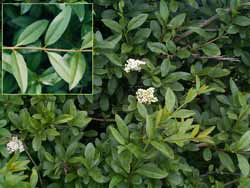Roadside
hedges
Remnants of hedges that may
have originally been mixed are found along Nottingham
Road and Grantham Road. These are old roads and though
these hedges may be ancient none has escaped damage
or modification. Thus, the species averages are mostly
between 3 and 4. Some may appear as hawthorn dominant
and have not been characterised as mixed. Many of them
contain damson and the hedge on the north side of Grantham
Road opposite the police station is predominantly damson.
This tree was widely grown in Bingham’s orchards.
The hedge that forms the eastern boundary to Walker’s
Field has an average of 4, but lacks the unusual species
typical of the other mixed hedges. Instead it contains
holly, cherry and sycamore. Holly is found as relatively
recent plantings in Fosters Lane nearby. Cherry was
grown in orchards near here in the nineteenth century,
while sycamore may have become established in them since
these hedges ceased to be properly maintained as hedges.
This hedge is mostly pre-1776, but has been modified
during the re-alignment of the Grantham Road.
The hedges along Tithby Road
are hawthorn dominant characteristically with hawthorn,
blackthorn and rose. Species averages are usually 2
– 3. Small-leafed elm, ash and dogwood all occur
rather uncommonly, but these hedges have all be enriched
by recent planting of such shrubs as purging buckthorn,
hazel, spindle and field maple in gaps created by the
removal of elder. The hedge along the west side of Granby
Lane is similar, but with crab apple and wych elm in
addition to hawthorn, blackthorn and rose.
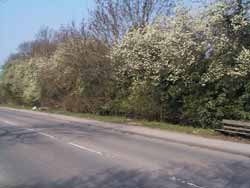
Bingham is famous
for its orchards and damson was widely grown in
the nineteenth century. Here it forms a hedge along
Grantham Road.
Photo: Peter Allen |
Town
hedges
The Sanderson map shows a field pattern for the area
of Bingham that probably had not changed since at least
the 16th century. There were many long, narrow closes
behind cottages running north-south off the main east-west
roads; Long Acre (Husbandman Street in pre-nineteenth
century times), Nottingham Road, Grantham Road, The
Banks and Newgate Street. Very few of these old hedges
have survived the growth of urban Bingham. One that
has is along the east side of Dark Lane. Though much
interrupted by gateways, short stretches of it remain
as front garden hedges. Ignoring the recent garden introductions
and seedlings this still has a total species count of
nine including hazel, which seems to be characteristic
of old hedges, and wild privet. The average is 6. Another
remnant is the hedge along the northern part of the
eastern boundary of Robert Miles Junior School playing
field, which contains hazel. It is the original eastern
boundary of the rectory grounds, which were known to
be here in 1586. Similar remnants of old hedges may
still survive as garden boundaries elsewhere in the
town. One particularly interesting hedge in the town
is the yew hedge in the Robert Miles Junior School grounds.
The yew hedge is said to be 360 years old.
Hawthorn Enclosure hedges
North of the railway line very few of the hedges shown
on Sanderson’s map and probably attributable to
the 1680-90 enclosure period now remain. Among those
that do the species range is limited. They are primarily
hawthorn hedges with rose and elder. Blackthorn and
ash are occasionally found. Wych elm is rare. The most
interesting set of hedges here are the ones that line
the western side of the track that leads from the end
of Moor Lane towards the Margidunum roundabout ending
at the southern boundary of what used to be Bull Moor.
This is believed to be the original, possibly Medieval
road from Bingham to East Bridgford. It runs across
West Moor and may not have been hedged in Elizabethan
times. Unusually for hawthorn enclosure hedges it contains
wild privet in addition to hawthorn, elder, rose, ash
and blackthorn.
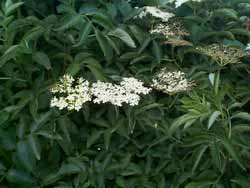
Elder is the fourth
most common shrub in the hedgerows of Bingham. It
is a short-lived species, but colonises easily.
Photo: Peter Allen |
South of the A52 and east of the
Linear Park the hedges have almost all gone. Those that
remain are shown on Sanderson and all but three are
pre-1776. Despite low average species they have an interesting
diversity. They are basically hawthorn hedges. Elder,
blackthorn and, less commonly rose, are the commonest
additional hedge species. Ash, wych elm and small-leaved
elm are the tree species probably planted with the hawthorn
for coppicing or timber. In addition, however, field
maple, hazel and wild privet occur in one or two places,
indicating, perhaps, that some very old hedges may have
been incorporated in the new hawthorn ones. Part of
this area consists of land that was not owned by the
Earl of Chesterfield, but may have been one of the estates
that originated from the other medieval manors in Bingham.
Nothing is known of the enclosure history in these areas.
Between Tithby Road and the
Linear Park there is a similar drastic reduction in
the number of hedges. Of those that remain the species
average ranges from 1.4 to 3.0. There is no particular
pattern to them. Two of these hedges are blackthorn
dominant West of Tithby
Road most of the hedges shown on Sanderson remain. This
was the area where traditional farming practices continued
the longest in the parish. Including the possibly old
mixed hedges, fourteen species are found in them. The
main ones are hawthorn (100% of hedges), blackthorn
(75%), rose and elder (each 55%), ash and field maple
(each 43%) and crab apple (25%). Other species are wych
elm and small-leaved elm, oak, dogwood (3 hedges), hazel
(2 hedges), wild privet (2 hedges) and purging buckthorn
(2 hedges). Most of these hedges average between 2 and
3 species. There is no discernable pattern to the spread
of the averages, even around the boundaries of a single
field, and even hedges with very low averages may have
several species spread thinly. Some of those with low
averages have characteristics of hedges that have been
substantially replanted or repaired in the last 50 to
100 years. On both sides of Tithby Road, the hedges
on Whitefields and Spring farms, have been substantially
modified in the last few years by the addition of several
species to fill gaps, many made by grubbing up elder.
These include, blackthorn, field maple, spindle, purging
buckthorn, hazel and even willow.
|
Top
Brackendale Farm
There are several relatively
species rich hedges in the area between Top Brackendale
Farm and the now derelict Foss Farm on the A46 south
of the Saxondale roundabout. This is within the area
of the three medieval arable fields that were enclosed
in 1680-90. They all coincide with hedges known to be
pre-1776. Three of them are high species average mixed
hedges. Two are boundaries to fields in what was called
the Saxondale Lanes Closes and Cross Mears. Both are
good, mixed hedges, one with hazel. The other, also
with hazel is, is near Top Brackendale Farm and has
no known association with any ancient boundary. Three
other hedges have average species counts of less than
4, but one of them contains dogwood and wild privet.
The other two lie along the medieval field boundaries
between South and Brackendale fields. The species range
for these hedges is 3.2 to 4.7. All the other hedges
in this area are simple, hawthorn dominant pre-1776
hedges.
Parish
boundary hedges
The medieval and Elizabethan practice of grazing sheep
on the open fields of Bingham during the winter months
suggests that good boundaries were needed to confine
the animals. Much of the parish is bounded by deep drainage
ditches and the River Smite, which would not need the
addition of hedges to keep sheep in, but long stretches
along the A46, Granby Lane and New Lane would have required
hedges. Evidence for them, however, has largely been
destroyed during road improvements when new or replacement
hawthorn hedges were planted. This is particularly so
along the A46 from Margidunum to the Moothouse Pit,
where the one remaining stretch of probable Elizabethan
hedge is to the north of Foss Road Farm, part of the
set of hedges that bounded Lowker Close in Chapel Field.
From the A46 south-eastwards
the parish boundary borders the medieval Brackendale
Field. There were 16 closes along the boundary in 1776
and there was a lane along it for about one mile southwards
from the A46. This was ploughed up within living memory.
The hedges have a low species count (1 to 1.7 with one
at 2.6) and are mainly hawthorn, but there are interesting
very short lengths that are species rich and include
wych elm, small-leaved elm and hazel. These are possibly
all that remains of the original Elizabethan hedges
here.
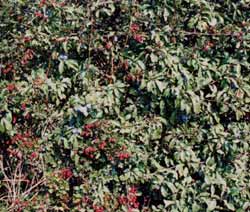 Blackthorn is the
second most common hedgerow shrub. Here it grows
intimately with hawthorn.
Blackthorn is the
second most common hedgerow shrub. Here it grows
intimately with hawthorn.
Photo: Peter Allen
|
The whole of the southern boundary
from the Fosse Way eastwards to the Smite is marked by
a major dyke. Hedges are discontinuous along it. There
are occasional oak trees, which are not common in the
parish, but traditionally have been used to mark boundaries.
The hedges are rich in blackthorn and mostly it grows
out of the northern side of the dyke. Species diversity
is not great, but averages range from 2 to 4.7 with long
stretches over 3. Even though they are now cut, at least
on one side if not the top, it is most likely that these
were never planted hedges, but grew naturally along the
dyke and are now cut for the sake of tidiness. No age
significance can be attributed to them. One interesting
hedge is the short stretch along the Linear Park where
the railway line, built in 1879, cut across the parish
boundary. The hedge post-dates the railway. It has a species
average of 3 and there are six different species in it.
All are growing through the remains of a fence. Again,
this is likely to be a self-generated hedge, not a planted
one. The partial
hedges along the Smite have a similar origin to those
along the southern boundary dyke. The Smite was straightened
between 1883 and 1899, which gives perhaps, a possible
oldest date for these hedges.
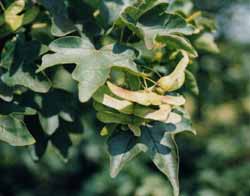 Common in the 1680-90
hedges, field maple is usually laid and cut with
the hedge.
Common in the 1680-90
hedges, field maple is usually laid and cut with
the hedge.
Photo: Peter Allen
|
From Thorough Bridge northwards
along Granby Lane the hedges average 2.4 to 2.7. They
are hawthorn hedges with some elder, blackthorn, rose,
crab apple and wych elm. The hedge along the north side
of the A52 from the end of Granby Lane to New Lane also
has an average of 2.7, but the assemblage of species is
totally different. It consists of hawthorn, ash, blackthorn,
hazel, field maple and wild privet, all species characteristic
of the probable Elizabethan hedges in this area. The adjacent
field boundary, which is the southern two hundred metres
of the parish boundary along New Lane, is a mixed hedge
with an average of 4.7. It is likely, then, that the A52
stretch is also old, but has been adulterated with more
recent planting of hawthorn to strengthen weakened lengths
of hedge. The hedges along New Lane on either side of
the entrance to Brocker Farm are modern replacement hedges.
The north-eastern
boundary from New Lane to Margidunum, except for the
stretch from New Lane to the railway line, is mostly
along dykes. The hedge is discontinuous and, except
where it is along the Holme Farm road, it is not well
looked after. Species diversity is low. There is a lot
of blackthorn in it and, like the southern boundary,
it is probably natural growth along the dykes that has
been cut for neatness.
1776
– 1840 hedges
There are a few hedges scattered about the parish that
were not on the 1776 maps, but appeared for the first
time either on Sanderson or the later Tithe map. The
species averages range from 1 to 3, but the species
range is low, mostly hawthorn, elder and rose. Blackthorn
is rare as are ash and small-leafed elm. The most interesting
is the western boundary to the area, now in Toot Hill
school, that was designated as garden strips on the
Tithe map of 1840.Perhaps it was the gardeners who planted
crab apple with the hawthorn. This is the only hedge
of this or younger age with crab apple.
There are several hedges in places
that can be characterised only as pre-1840 because they
lie outside the Chesterfield estate. Four of them are
to the east of Carnarvon school. They are unexceptional
except for one with an average of 4 that includes dogwood,
wych elm, ash, hawthorn, rose, blackthorn and hawthorn.
Post-1950
Farm hedges that appear to have been created in the
last fifty years are to be found near the buildings
at Brocker Farm. Hedges on either side of the entrance
to the farm along New Lane have been replanted in recent
decades, while in the south-west of the parish there
is one newly planted hedge near Lower Brackendale Farm
that cannot be dated. Elsewhere, the new hedges are
all associated with road building or improvement. These
are along the new Chapel Lane, marginal to the Margidunum
roundabout and along the A52. All the new farm boundary
hedges here are primarily hawthorn. The species of hawthorn
used along the A52 is said to be not an English native
one, but Dutch in origin. After only 16 years some of
these new hedges are colonised in places by blackthorn,
rose and elder. This is possibly because only the field
side of these hedges is cut and the embankment and verges
on the other side are mostly allowed to grow wild. Along
the A46 south of Saxondale roundabout, where the new
hedge and the verge are cut, the hedge remains pure
hawthorn.
Only one stretch of the hedge along
new Chapel Lane appears to have been planted as a mixed
hedge in 1969. Here wayfaring tree, rose, damson and
spindle were mixed with hawthorn and blackthorn for
about 150 metres.
In the 1987 planting along
the A52 the whole of the hedge on the north side between
the junction with Grantham Road and the Saxondale roundabout
is mixed. This hedge was always planned to be marginal
to housing developments rather than fields. There are
four varieties of plum, along with wayfaring tree, dogwood,
guelder rose, hazel, ash and spindle mixed in with the
staples of hawthorn, blackthorn, field maple and dog
rose.
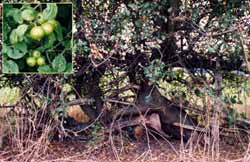 Crab apple is quite
common in the parish. It is recorded elsewhere
as being purchased along with hawthorn and elm
by landowners who were planting hedges in the
18th century. This might have happened here. It
is usually cut in the hedge, as here, though some
have been left to grow into trees.
Crab apple is quite
common in the parish. It is recorded elsewhere
as being purchased along with hawthorn and elm
by landowners who were planting hedges in the
18th century. This might have happened here. It
is usually cut in the hedge, as here, though some
have been left to grow into trees.
Photo: Peter Allen |
|
![]()

